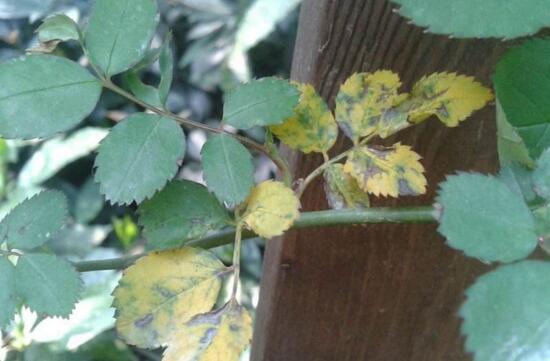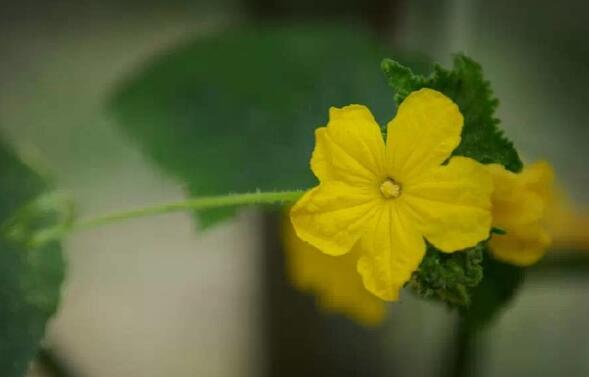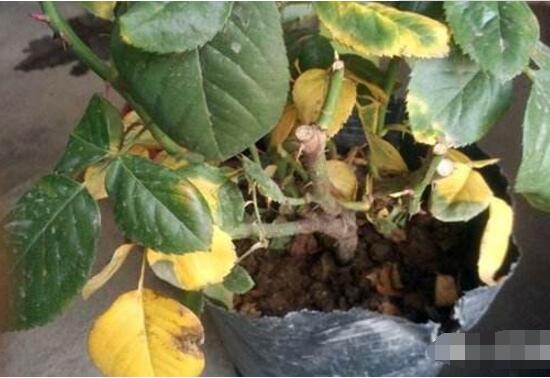How to do the rose leaves yellowing? pay attention to 5: 00 away from yellowing trouble / light is the key.
As a good product of indoor breeding, the rose is the object chosen by many novices, because it is not only easy to raise, but also very beautiful. However, in the process of breeding, because of improper maintenance and other problems, there will be symptoms of yellowing leaves, then how to do the leaves of roses yellowing? First of all, we need to calm down, and then carefully find the cause of the yellowing of the leaves, and finally solve the problem.
First, the rose leaves yellowing how to do, find the cause

In the rose culture method, we know that the rose has requirements for soil, light, watering and so on. Once the standard is not up to standard, the leaves will turn yellow and come to the door. As for the rose leaves yellow how to do, first of all, the rose vitality is very strong, so we do not worry, to calmly find the cause, and then solve it. The following are the reasons and solutions for the yellowing of rose leaves arranged by Xiaobian, be sure to take a look.
Second, the causes and solutions of the yellowing of rose leaves.
1. The basin has not been changed for a long time
Once the rose leaves turn yellow, we will think of a variety of reasons, but the first thing we have to consider is potted soil. Because if the bought roses do not change pots and soil for a long time, their branches and leaves will grow thin, and the leaves will become thin and yellow.
Solution: very simple, just change the basin and change the soil. Rose flowers do not want the soil, flower friends can replace it with new loose and fertile soil.
2. Too much or too little watering
The young leaves at the tip of the rose are yellowish, the old leaves gradually turn yellow, and the new shoots atrophy, because too much watering leads to excessive wetness in the basin, lack of oxygen in the soil, rot of the beard roots, and then the leaves will turn yellow; the color of the top leaves of the rose is normal, but the lower leaves gradually dry yellow and fall off upward, which is generally due to the basin soil is too full and cannot be watered for a long time, resulting in the aging of the branches and stems of the lower leaves.
Solution: ① watering too much: put the rose off the pot in a ventilated, cool, self-drying soil mass and then put it back into the basin, or often loosen the soil and control watering; ② watering too little: appropriate watering to keep the soil moist.
Note: the rose is happy and moist and afraid of waterlogging. It can be watered 3 or 4 times according to the weather conditions from early spring sprouting to flowering, keeping the soil moist, remember not to water more, and not without watering. It is very important to grasp a degree.
3. Lack of light
The most likely reason for the yellow leaves of roses is lack of light. As we introduced earlier, roses are happy, and the stronger the light, the better. So if you keep the roses indoors for a long time, the leaves are easy to be yellow, because the leaves do not get enough sunlight to form chlorophyll, and the whole leaves turn yellow and fall off.
Solution: lack of light in ①: supplementary light can avoid this disease.
4. Lack of fertilizer causes yellowing of leaves.
Newly planted roses need to be fertilized in the soil in autumn, before spraying a small amount of chemical fertilizer solution, such as urea potassium dihydrogen phosphate 0.2% solution. If early fertilization is extremely easy to burn out the roots, resulting in yellowing of leaves, and even plant death.
Solution: although the rose likes to be fat, it should also have a degree. Fertilize 1-2 times in March.
5. Diseases and insect pests cause yellowing of leaves
In addition to the above reasons for the yellowing of rose leaves, longevity flowers harmed by diseases and insect pests can also cause yellow leaves to fall off. Among them, black spot mainly affects leaves, powdery mildew attacks tender leaves, and all kinds of insects also make rose leaves yellow.
Solution: find out what kind of diseases and insect pests are affected, and then solve the problem. As for the prevention and control of diseases and insect pests in roses, we will introduce them in detail separately, so we will not say much here.
Although the rose has strong vitality and is easy to raise, it will also get sick if we neglect it, and the yellowing of leaves is just one of the manifestations. However, after the leaves turn yellow, we only need to do what is said above, and the problem of yellowing can also be easily solved. With regard to the yellow leaves of roses, this is the end of the introduction. I hope I can give you some help.
How to do the rose leaves yellowing, 5 reasons and treatment methods
Raised rose leaves yellow how to do, I believe that many maintenance of rose flowers have encountered, in fact, lead to rose leaves yellow for many reasons, the following collation of 5 common reasons and treatment methods.
What to do if the rose leaves turn yellow? 1. The light is unreasonable.
When maintaining the rose, if the rose is placed in a place where the light is too strong, it will cause the rose leaves to be yellow and distracted. If the light is too dark, stuffy and unventilated, and the air is dry, it will also cause the leaves of roses to turn yellow.
What to do
It is suggested that flower friends can plant rose pots in places where the sun is moderate and the environment is ventilated, such as balconies.
2. Irrational watering
Roses are afraid of too much water, if a little too much or too little watering, it will affect the root growth of roses, but also make the leaves of roses yellow. Especially if you encounter too many seasons of Rain Water, it is easy to cause rose root rot, water and nutrients can not be transported in time, rose leaves will appear yellowing phenomenon.
What to do
It is suggested that flower friends can water according to weather changes. Generally, when roses sprout in early spring, they should be watered 3-4 times a day, as long as the soil is kept moist.
When it is hot and dry in summer, it needs to be watered for 2-3 times, and it can be watered for 2-3 times in autumn, so we must pay attention to reasonable watering in different seasons.
3. Unreasonable fertilization
In general, newly planted roses should not be fertilized as soon as they are planted. They can not be fertilized until autumn. If they are fertilized prematurely, the roots will burn out and the roses will die.
At the same time, if you apply too much fertilizer, it will lead to roses burning roots, too little fertilization, lack of nutrients, will lead to yellow leaves.
What to do
Because the newly planted rose plant is very fragile, it is suggested that flower friends can properly spray foliar fertilizer, wait until autumn, and then fertilize the soil, reasonable fertilization can make the rose blossoms and leaves luxuriant.
4. Do not change soil for a long time
If the potted roses have to change the soil once every 3 to 6 months, if the soil is not changed for a long time, the soil nutrients are not enough, the roses do not get enough nutrients, and the leaves of the roses will turn yellow.
What to do
Pay special attention to changing the soil for potted roses, do not hurt the roots of the roses, at the same time, when the roses are moved back, do not press the soil too tightly, pour some water properly, and wait for the roses to come back to life in a sunny place.
5. Diseases and insect pests cause leaf yellowing
The common diseases of rose are: black spot, powdery mildew, rust and so on. As long as the rose leaves will appear different degrees of spots or disease, the leaves will gradually lose green and turn yellow, and when serious, the leaves will fall off a large number.
What to do
Flower friends as long as they find that there is a disease in the rose, they must deal with it in time, want to spray the corresponding agent on the leaf of the rose, generally once a week, but should pay attention to different spraying times, the duration is different.
How to reproduce Chinese rose? what about the yellowing leaves of rose?
Rose flowers have a variety of varieties and beautiful colors, which are very suitable for decorating and beautifying homes, but many people know little about how to raise rose. So, how do Chinese roses reproduce? What if the leaves of Chinese rose turn yellow? The following will give you a detailed introduction.
How to reproduce Chinese rose
1. Cuttage propagation
Cuttings should be tender and pay attention to heat preservation and moisturization during cutting. The cutting time of Catharanthus roseus is usually in spring, and we try to cut off a relatively tender branch as a cutting. it can be a tender strip on a new branch or a new one on an old branch, always tender, with two or three leaves at the top, and then insert the bottom of the branch into the wet sand. Try to control the temperature between 20 and 25 degrees during cutting. after watering, you can cover the basin soil and cuttings with a film to moisturize, and put the basin soil in a cool, ventilated place to wait for rooting.
2. Water insertion propagation
Pay attention to changing water more frequently and quickly in summer. The selection of water cuttings of Catharanthus roseus is similar to that of ordinary cuttings, and the truncated branches can be inserted directly into clear water, but always change water for cuttings, preferably every two days, to ensure the content and cleanliness of nutrients in clear water. When necessary, you can also add a few drops of nutrient solution to promote the rooting of water cuttings. Generally speaking, it takes about 20 days to take root.
3. T-shaped grafting
It is easy to peel off the phloem when the plant has more water content in the seedling growing season. When grafting, the scion selects full buds on the full new shoots of the same year, cuts off the leaves, retains the petiole, then takes a little xylem, and cuts a knife edge of 1.5 cm in length and 0.5 cm in width to form a T-shape. Then the bone part of the tail of the budding knife is used to pick out the incision so that the phloem is separated from the xylem. After gently ripping off the xylem of the grafting bud, it was inserted into the opening of the rootstock, so that the upper flat edge of the grafted bud was aligned with the cross-cutting edge of the rootstock, and the grafted bud was closely consistent with the cambium of the rootstock. Bind the wound with a plastic tape with a width of 0.6 cm to 0.8 cm and a length of about 20 cm to 25 cm to close the wound, exposing buds and petioles. After 5-7 days, the petiole was poked with your fingers, and the petiole was easy to fall off, that is, the grafting was successful, and it was unbound in time about 15 days after survival.
4. Grafting with buds.
It is a kind of single bud grafting when the cortex of rootstock is not easy to peel off in autumn and winter. The buds can be slightly xylem and cut into olive shape. The part of the rootstock is also cut into a similar section like budding. In the lower part of the incision, 2-3mm cross-cutting is left, and the residual pile is left a little to facilitate bud implantation. Align the bud with the cambium of the rootstock (the cortex is aligned with the naked eye) and bind it. This method is usually used to cut roses in Shanghai from September to October. Rooting cuttings are produced in November. After indoor grafting, they are planted in the seedbed at a distance of 10 to 15 centimeters. Plant 45 plants per square meter. The seedling bed should be covered with film or placed in the greenhouse, when the new seedling height is 30cm to 40cm, it can be planted.
5. Striping breeding method
Peel the rose branches in a ring and bury them in the soil, or wrap them in wet soil; after peeling the new roots, the branches can be cut off and transplanted, and the survival rate can reach 100%. The disadvantage is that the number of reproduction is small and the time is long. it is suitable for family use and is not suitable for mass reproduction such as flower fields.
What if the leaves of Chinese rose turn yellow?
1. Overwatering: although the rose likes a humid environment, it can not be watered blindly. If excessive watering, the leaves of the rose will turn yellow. At this time, you only need less watering to return to normal.
2. Lighting: rose flowers are flowers that like light. It is generally best to keep the light time for more than six hours. If you are not exposed to the sun for a long time, it will also cause the leaves to turn yellow. It can be solved as long as you move out to bask in the sun.
3. Poor ventilation: poor ventilation is also one of the reasons why rose leaves turn yellow, because the dry and muggy environment is easy to make rose leaves yellow.
4. Temperature: rose is a kind of plant that likes to be warm and afraid of heat. Too high or too low temperature will make its leaves turn yellow. Pay attention to the temperature change of the environment.
5. Fertilization: sometimes, in order to make the rose flowers grow better, we will fertilize more. In fact, too much fertilization will lead to burning, and then the leaves will turn yellow.
6. Insect pests: when the rose is attacked by red spiders, scale insects and other pests, it will also cause the leaves to turn yellow, we need to remove the pests, we can make the rose healthy.
7. Soil: rose flowers like loose, well-drained soil. If the soil is hardened and the roots are not breathable, it will also cause yellowing of leaves and, in serious cases, plant death.
The above are some answers about how to reproduce rose flowers and how to make their leaves yellow. Is it clear to all? Please pay attention to more household knowledge.
- Prev

How to do morning glory leaves yellow, learn 6 strokes yellow worry-free/watering too low temperature
Morning glory, needless to say we all know, it is also called morning glory, often appear in the countryside roadside, is a flower friends like flowers. Nowadays, many flower friends plant morning glory at home, but because of improper maintenance, there are often some problems, such as yellowing leaves.
- Next

What if the leaves of Chinese rose turn yellow and dry? the reason for the yellowing of rose flowers (cutting withered leaves and spraying)
Rose is a kind of indoor flower that is easy to raise. If you learn the cutting method of rose, you can make sure that one pot can be changed into ten pots. Earlier, we talked about how to raise rose flowers and the efficacy, function and taboo of rose flowers. Now let's talk about a very common question: what to do if the leaves of rose flowers turn yellow and dry?
Related
- Fuxing push coffee new agricultural production and marketing class: lack of small-scale processing plants
- Jujube rice field leisure farm deep ploughing Yilan for five years to create a space for organic food and play
- Nongyu Farm-A trial of organic papaya for brave women with advanced technology
- Four points for attention in the prevention and control of diseases and insect pests of edible fungi
- How to add nutrient solution to Edible Fungi
- Is there any good way to control edible fungus mites?
- Open Inoculation Technology of Edible Fungi
- Is there any clever way to use fertilizer for edible fungus in winter?
- What agents are used to kill the pathogens of edible fungi in the mushroom shed?
- Rapid drying of Edible Fungi

